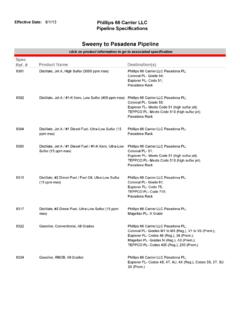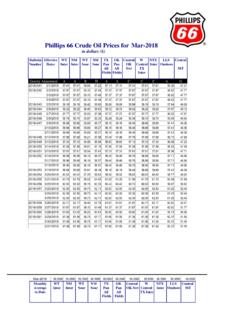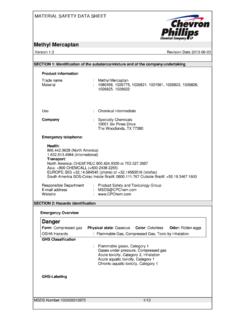Transcription of Safety Data Sheet PULSALube Universal 1 HG …
1 Safety Data Sheet 1 | P a g e SECTION 1: Identification PULSALube Universal 1 HG hydraulic & gear Oil Product Identifier Multipurpose R&O Oil Other means of identification phillips 66 Multipurpose R&O Oil 22 phillips 66 Multipurpose R&O Oil 32 phillips 66 Multipurpose R&O Oil 46 phillips 66 Multipurpose R&O Oil 68 phillips 66 Multipurpose R&O Oil 100 phillips 66 Multipurpose R&O Oil 150 phillips 66 Multipurpose R&O Oil 220 phillips 66 Multipurpose R&O Oil 320 phillips 66 Multipurpose R&O Oil 460 Code LBPH778978 Relevant identified uses Circulating Oil Uses advised against All others 24 Hour Emergency Phone Number CHEMTREC 1-800-424-9300 CHEMTREC Mexico 01-800-681-9531 Manufacturer/Supplier phillips 66
2 Lubricants Box 4428 Houston, TX 77210 SDS Information URL: Phone: 800-762-0942 Email: Customer Service : 800-368-7128 or International: 1-832-765-2500 Technical Information 1-877-445-9198 Classified Hazards Hazards Not Otherwise Classified (HNOC) H412 -- Hazardous to the aquatic environment, chronic toxicity -- Category 3 PHNOC: None known HHNOC: None known Chemical Name CASRN Concentration Distillates, petroleum, solvent-dewaxed heavy paraffinic 64742-65-0 <100 Residual oils, petroleum, solvent-dewaxed 64742-62-7 <100 Distillates, petroleum, hydrotreated heavy paraffinic 64742-54-7 <95 Lubricating oils, petroleum, hydrotreated spent 64742-58-1 <40 2,6-Di-tert-butylphenol 128-39-2 - All concentrations are percent by weight unless ingredient is a gas.
3 Gas concentrations are in percent by volume. SECTION 2: Hazard identification Label Elements Harmful to aquatic life with long lasting effects Avoid release to the environment; Dispose of contents/container to an approved waste disposal plant SECTION 3: Composition/information on ingredients Safety Data Sheet 2 | P a g e Eye Contact: If irritation or redness develops from exposure, flush eyes with clean water. If symptoms persist, seek medical attention. Skin Contact: First aid is not normally required. However, it is good practice to wash any chemical from the skin. Remove contaminated shoes and clothing and cleanse affected area(s) thoroughly by washing with mild soap and water or a waterless hand cleaner.
4 If irritation or redness develops and persists, seek medical attention. Inhalation: First aid is not normally required. If breathing difficulties develop, move victim away from source of exposure and into fresh air in a position comfortable for breathing. Seek immediate medical attention. Ingestion: First aid is not normally required; however, if swallowed and symptoms develop, seek medical attention. Most important symptoms and effects, both acute and delayed: Prolonged or repeated contact may dry skin and cause irritation. Inhalation of oil mists or vapors generated at elevated temperatures may cause respiratory irritation. Accidental ingestion can result in minor irritation of the digestive tract, nausea and diarrhea.
5 Notes to Physician: Acute aspirations of large amounts of oil-laden material may produce a serious aspiration pneumonia. Patients who aspirate these oils should be followed for the development of long-term sequelae. Inhalation exposure to oil mists below current workplace exposure limits is unlikely to cause pulmonary abnormalities. NFPA 704 Hazard Class Health: 0 Flammability: 1 Instability: 0 0 (Minimal) 1 (Slight) 2 (Moderate) 3 (Serious) 4 (Severe) Extinguishing Media: Dry chemical, carbon dioxide, foam, or water spray is recommended. Water or foam may cause frothing of materials heated above 212 F / 100 C. Carbon dioxide can displace oxygen. Use caution when applying carbon dioxide in confined spaces.
6 Simultaneous use of foam and water on the same surface is to be avoided as water destroys the foam. Specific hazards arising from the chemical Unusual Fire & Explosion Hazards: This material may burn, but will not ignite readily. If container is not properly cooled, it can rupture in the heat of a fire. Hazardous Combustion Products: Combustion may yield smoke, carbon monoxide, and other products of incomplete combustion. Oxides of sulfur, nitrogen or phosphorus may also be formed. Special protective actions for firefighters: For fires beyond the initial stage, emergency responders in the immediate hazard area should wear protective clothing. When the potential chemical hazard is unknown, in enclosed or confined spaces, a self contained breathing apparatus should be worn.
7 In addition, wear other appropriate protective equipment as conditions warrant (see Section 8). Isolate the hazard area and deny entry to unnecessary and unprotected personnel. Stop spill/release if it can be done safely. Move undamaged containers from immediate hazard area if it can be done safely. Water spray may be useful inminimizing or dispersing vapors and to protect personnel. Cool equipment exposed to fire with water, if it can be done safely. Avoid spreading burning liquid with water used for cooling purposes. See Section 9 for Flammable Properties including Flash Point and Flammable (Explosive) Limit Personal precautions, protective equipment and emergency procedures: This material may burn, but will not ignite readily.
8 Keep all sources of ignition away from spill/release. Stay upwind and away from spill/release. Avoid direct contact with material. For large spillages, notify persons down wind of the spill/release, isolate immediate hazard area and keep unauthorized personnel out. Wear appropriate protective equipment, including respiratory protection, as conditions warrant (see Section 8). See Sections 2 and 7 for additional information on hazards and precautionary measures. SECTION 4: First aid measures SECTION 5: Firefighting measures SECTION 6: Accidental release measures Safety Data Sheet 3 | P a g e Environmental Precautions: Stop and contain spill/release if it can be done safely.
9 Prevent spilled material from entering sewers, storm drains, other unauthorized drainage systems, and natural waterways. Use water sparingly to minimize environmental contamination and reduce disposal requirements. If spill occurs on water notify appropriate authorities and advise shipping of any hazard. Spills into or upon navigable waters, the contiguous zone, or adjoining shorelines that cause a sheen or discoloration on the surface of the water, may require notification of the National Response Center (phone number 800-424-8802). Methods and material for containment and cleaning up: Notify relevant authorities in accordance with all applicable regulations. Immediate cleanup of any spill is recommended.
10 Dike far ahead of spill for later recovery or disposal. Absorb spill with inert material such as sand or vermiculite, and place in suitable container for disposal. If spilled on water remove with appropriate methods ( skimming, booms or absorbents). In case of soil contamination, remove contaminated soil for remediation or disposal, in accordance with local regulations. Recommended measures are based on the most likely spillage scenarios for this material; however local conditions and regulations may influence or limit the choice of appropriate actions to be taken. See Section 13 for information on appropriate disposal. Precautions for safe handling: Keep away from flames and hot surfaces.










